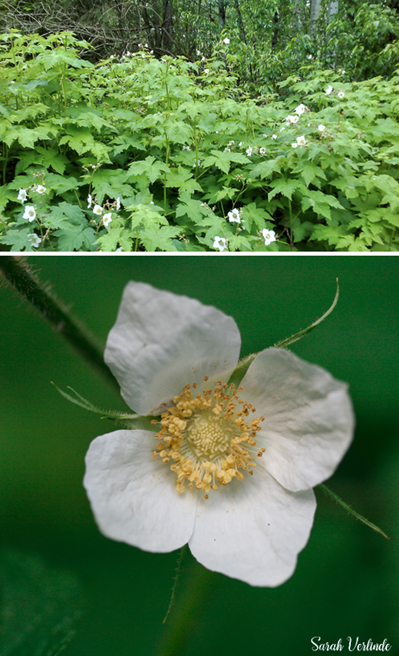Thimbleberry
Rubus parviflorus – Thimbleberry
Rubus nutkanus was separated as a distinct species from Rubus parviflorus, it’s former name, in 2018. However, in 2019 the name change was placed on hold, and Rubus parviflorus is still ok to be used until the discussion is settled. Read a little bit more about this.

At a Glance:
- Family: Rosaceae
- Plant Type: erect deciduous shrub
- Distribution: Western North America, California to Alaska, as far east as Montana
- Habitat: wooded to open areas, low to subalpine elevations
- Height: 5 feet
- Flower/Fruits: white flowers with a yellow center, fruit ripens to a sweet red “berry”, looking like a raspberry or thimble.
- Flowering Season: May – July
- Leaves: large maple-like leaves, lobed
- Generation: Perennial
- Bark: gray flaking bark
- Notable feature: leaves are very soft and feel like velvet, especially during the spring.
Restoration and Conservation
Thimbleberry is a great plant to use in restoration which is fairly easy to grow and supports wildlife. The flowers are a good nectar source for pollinators like hummingbirds, bees, butterflies, and other insects. The berries support birds, bears, and small mammals. Leaves and twigs are grazed on by deer and elk, and the dense stems provide a thicket habitat for small birds and mammals to shelter in.
Thimbleberry establishes quickly in habitats affected by degradation, fire, or clear cutting. It was one of the first shrubs to establish after the Mt. St. Helens eruption, just four months later.
Ethnobotany
The berries are edible and delicious and were an important fruit in many Native American diets. *Don’t eat the berries on campus or along roadsides due to possible contamination.* The shoots in early spring could be harvested and eaten like a raw green vegetable. Competition with birds is high, so unripe berries were collected and allowed to ripen in baskets. Leaves are soft and large, and were used for storage, or made into a tea for medicinal uses.
References and Resources
- FEIS/USDA: https://www.fs.fed.us/database/feis/plants/shrub/rubpar/all.html
- Native Plants PNW: http://nativeplantspnw.com/thimbleberry-rubus-parviflorus
- WTU Image Herbarium: http://biology.burke.washington.edu/herbarium/imagecollection/taxon.php?Taxon=Rubus%20nutkanus
This article was written by Sarah Verlinde. For questions regarding the UWB/CC Plant Tour, contact Sarah at severlin@uw.edu.
